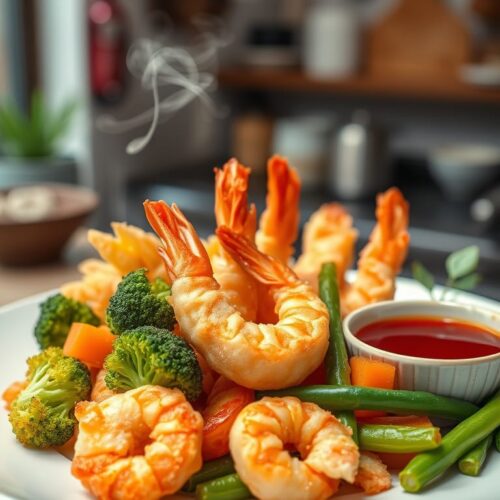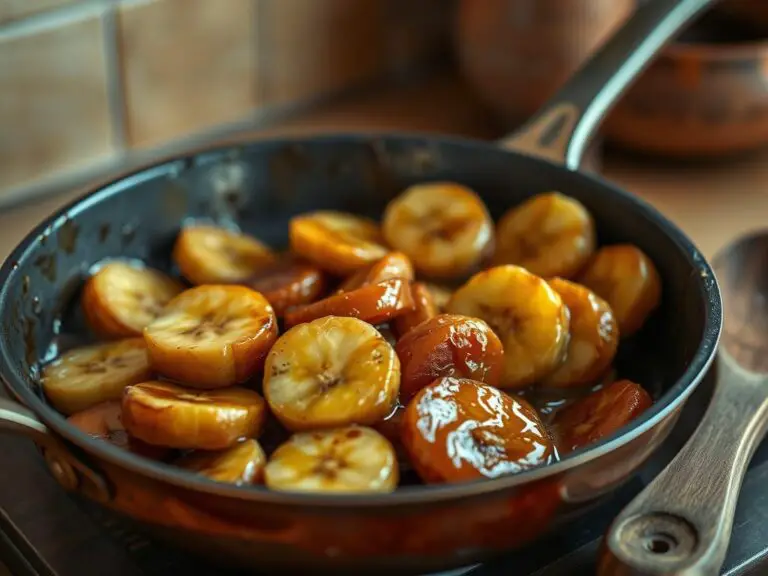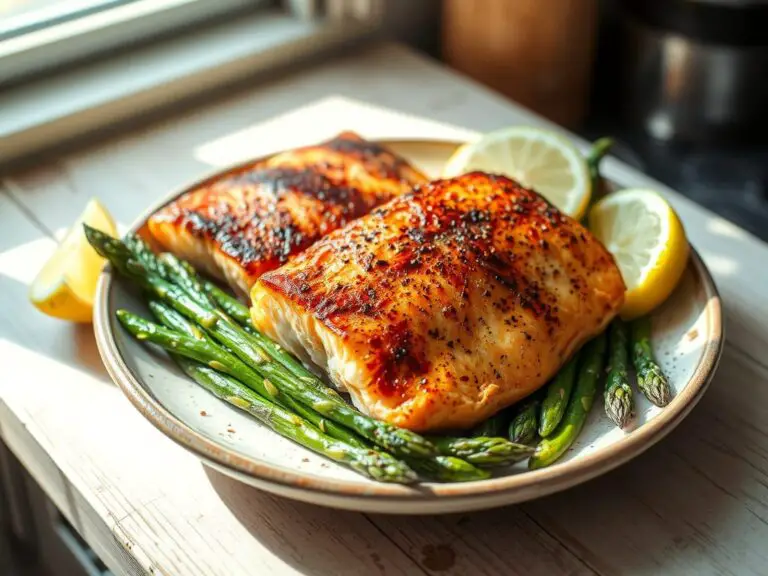The Ultimate Japanese Tempura Recipe: Crispy Perfection Every Time
Ever had that crispy, light-as-air tempura at your favorite Japanese restaurant and wondered if you could recreate that magic at home? Well, guess what – you absolutely can! Whether you’re a tempura newbie or a seasoned home cook, this ultimate Japanese Tempura recipe will guide you step by step to achieve that perfect, crunchy goodness that makes tempura so irresistibly delicious. Imagine impressing your guests with beautifully golden, crispy shrimp and veggies that taste just like from a high-end sushi bar. From selecting the freshest ingredients to mastering that light batter, get ready to make tempura a regular star in your kitchen.
Making tempura at home might seem daunting, but we’ve got you covered. Through this guide, you’ll discover why tempura, with its signature crisp exterior and tender interior, is a beloved staple in Japanese cuisine. With a flavor that’s both indulgent and light, and a cooking technique that’s easy once you know the tricks, tempura makes any meal a special occasion. Plus, serving a platter of perfectly fried shrimp and veggies isn’t just a feast for the taste buds but a visual treat that makes your dinner table shine. Ready to dive into the art of tempura? Let’s get started!

As an Amazon Associate, I earn from qualifying purchases. This post may contain affiliate links, which means I may receive a commission if you purchase through my links, at no extra cost to you.
Key Ingredients for The Ultimate Japanese Tempura
The magic of tempura lies in its simplicity and the quality of its ingredients. Here’s what you need:
- All-purpose flour: It forms the base of the tempura batter.
- Cornstarch: Adds extra crispiness to the batter.
- Baking powder: Helps make the batter light and airy.
- Salt: Adds flavor to the batter.
- Ice water: Keeps the batter cold which is crucial for a crispy tempura.
- Vegetable oil: For frying; make sure it’s a high smoke point oil like canola or sunflower.
- Assorted vegetables: Broccoli florets, sliced sweet potatoes, green beans, or any veggies you prefer.
- Seafood: Shrimp, scallops, or fish fillets work great here; make sure to pat them dry.
- Dipping sauce: A classic tentsuyu sauce made from dashi, soy sauce, and mirin completes the tempura experience.
How to Make The Ultimate Japanese Tempura
Making tempura is all about keeping things cold and working quickly. Here’s a step-by-step guide to mastering this crispy delight:
- Start by preparing your vegetables and seafood. Cut your vegetables into bite-sized pieces and pat your seafood dry with paper towels to ensure they are completely dry before dipping into the batter.
- Next, make the batter. In a bowl, whisk together the flour, cornstarch, baking powder, and salt. Gradually add ice water while whisking gently. Don’t worry about lumps; a lumpy batter is actually a good thing here!
- Heat a deep fryer or a large pot filled with about 2-3 inches of vegetable oil until it reaches 350°F (175°C). An instant-read thermometer can help you keep track of the oil’s temperature.
- To coat your vegetables and seafood, dip them first into a light dusting of extra flour if desired (this helps the batter adhere better), then dip them into the batter, ensuring a light coating. Do this one item at a time.
- Carefully place the battered items into the hot oil, making sure not to overcrowd the fryer. Fry until golden brown and crispy, which should take about 2-3 minutes. Halfway through, gently flip the pieces to cook evenly on both sides.
- Remove the fried tempura from the oil with a slotted spoon or tongs and place them on a wire rack set over a baking sheet to drain any excess oil. Serve immediately with your favorite dipping sauce like tentsuyu sauce made from dashi, soy sauce, and mirin.
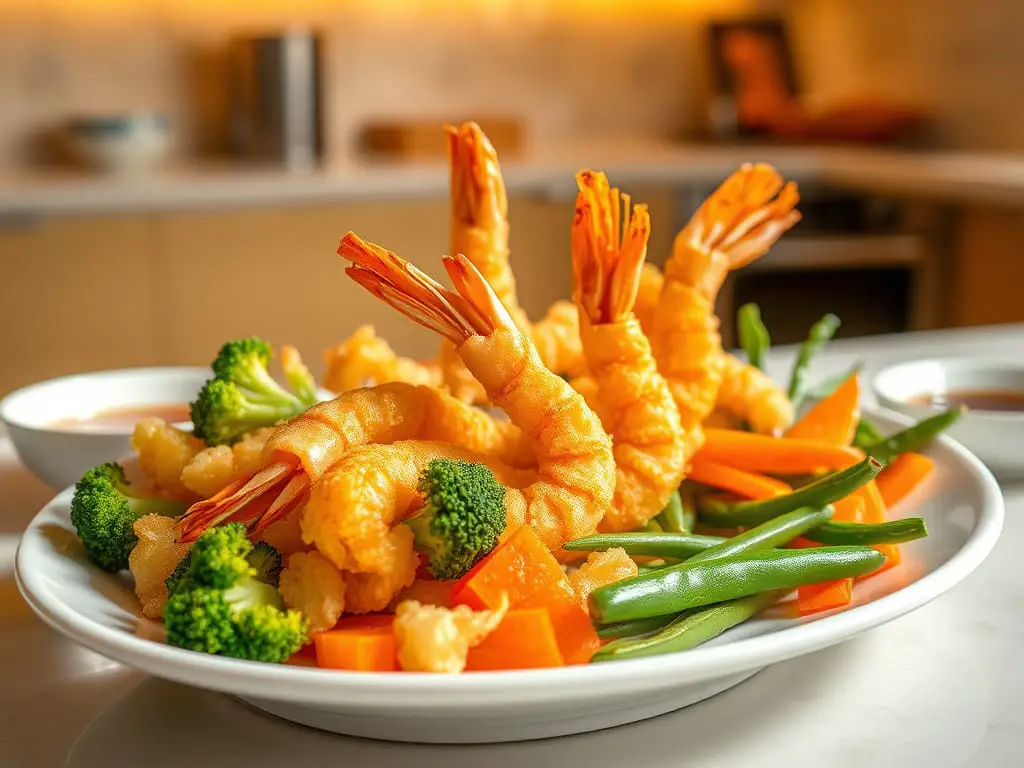
Variations of Japanese Tempura
Stepping into the world of tempura flavors doesn’t stop at shrimp and veggies. Here are some variations to try out:
- Vegetable Tempura: Focus on a variety of veggies such as bell peppers, mushrooms, zucchini, or eggplant.
- Seafood Tempura: Beyond shrimp and scallops, try using squid rings, soft-shell crab, or even thin slices of fish like cod or tilapia.
- Mixed Tempura Platter: Mix vegetables and seafood together for a colorful and flavorful assortment.
- Herb Tempura: For a unique twist, try tempura-frying herbs like basil leaves or parsley for a crispy and aromatic garnish.
Pairings and Serving Suggestions
Tempura is traditionally served with a dipping sauce called tentsuyu made from dashi, soy sauce, and mirin, but there are also other delightful pairings:
- Loved the crispy texture of our Tempura? Pair it with our Udon Recipe for a satisfying combination.
- Grated Daikon Radish and Ginger: Serve alongside a soy-based dipping sauce with a touch of grated daikon radish and ginger for extra zing.
- Tempura Donburi (Tendon): Serve tempura over a bowl of steamed rice and drizzle with a sweet soy sauce for a delicious meal.
- For a delicious appetizer before your Tempura, try our Gyoza Recipe.
- The light, crispy textures of the Tempura are beautifully complemented by the refreshing zest of a Japanese Lemon Sours Cocktail.
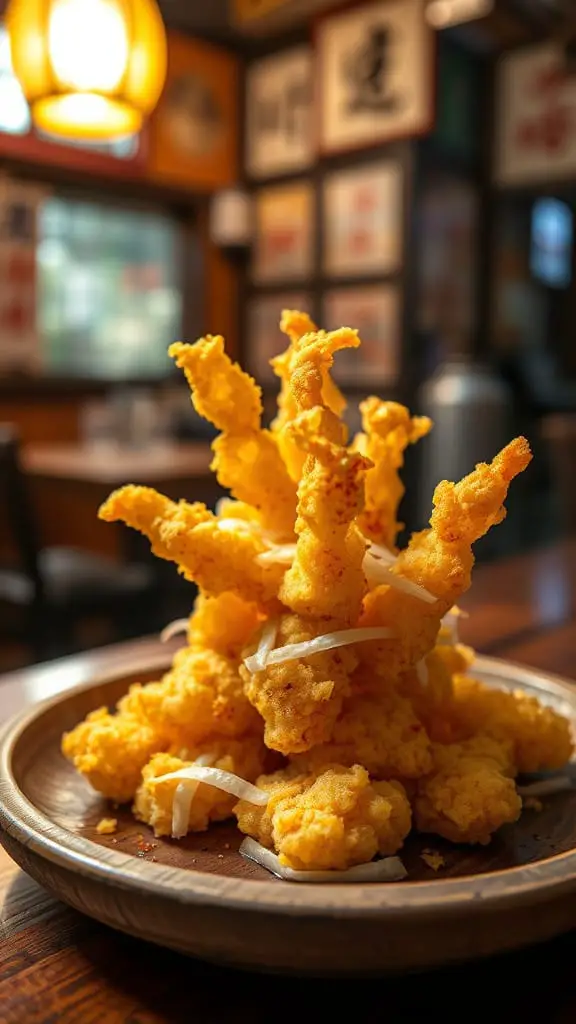
For a full Japanese-themed meal, pair your tempura with these other recipes:
- Miso Soup: A comforting and savory soup that perfectly complements the crispy tempura.
- Sushi Rolls: A sushi platter makes a fantastic accompaniment for a diverse and flavorful meal.
Common Mistakes to Avoid When Making Tempura
Making tempura might seem straightforward, but there are common pitfalls to watch out for:
✖ Overmixing the Batter: Mix until just combined — a few streaks of flour remaining is actually a good thing. Overmixing leads to gluten formation which makes the batter heavy.
✖ Using Warm Water: Make sure your batter stays cold. Using ice water helps keep the batter light and crispy.
✖ Overcrowding the Fryer: Fry in small batches to avoid a drop in oil temperature which makes the tempura oily instead of crispy.
✖ Frying at the Wrong Temperature: The oil should be at 350°F (175°C). Too hot burns the tempura quickly while too low makes it greasy.
Tips and Tricks
Here are some pro tips to make your tempura perfect every single time:
✔ Keep Everything Cold: Chill the batter and make sure your vegetables/seafood are dry but cold when you dip them into the batter.
✔ Dry Ingredients: Pat dry your vegetables and seafood thoroughly. Any excess moisture makes the batter soggy.
✔ Preheat Your Serving Plate: Placing freshly fried tempura on a hot oven-proof dish can keep it warm without making it soggy while you finish frying the rest.
✔ Immediate Consumption: Tempura is best eaten hot and fresh. Avoid letting it sit around once it’s been fried.
Final Thoughts
With this ultimate Japanese tempura recipe, you now have all the tips and tricks to make your tempura night a huge success every single time. From picking the freshest ingredients to making the perfect crispy batter, your tempura is bound to rival any restaurant’s.
Don’t be afraid to experiment with different vegetables and seafood combinations. Serve it up with a variety of dips and pairings for a full-blown Japanese feast at home. Remember, making tempura is as much about the process as it is about the delicious result. So, put on your chef’s hat and get frying!
The Ultimate Japanese Tempura Recipe: Crispy Perfection Every Time
Ingredients
- 1 cup all-purpose flour plus extra for dusting
- 1/2 cup cornstarch
- 1 teaspoon baking powder
- 1/2 teaspoon salt
- 1 cup ice water
- Vegetable oil for frying
- Assorted vegetables e.g., broccoli florets, sliced sweet potatoes, green beans
- Seafood e.g., shrimp, scallops, fish fillets, cleaned and patted dry
- Dipping sauce e.g., tentsuyu sauce – dashi, soy sauce, mirin
Instructions
- Prepare the Vegetables and Seafood: Wash and cut your vegetables into bite-sized pieces. Pat the seafood dry with paper towels.
- Make the Batter: In a bowl, whisk together the flour, cornstarch, baking powder, and salt. Gradually add the ice water while whisking gently. It’s okay if there are some lumps.
- Heat the Oil: Pour vegetable oil into a deep fryer or a large pot to a depth of about 2-3 inches. Heat the oil to 350°F (175°C).
- Coat and Fry: Dip the prepared vegetables and seafood into the batter, ensuring they are lightly coated. Carefully place the battered items into the hot oil, being careful not to overcrowd the fryer.
- Fry to Crispness: Fry the tempura for 2-3 minutes, or until golden brown and crispy. Flip the items halfway through to ensure even cooking.
- Drain and Serve: Remove the tempura from the oil with a slotted spoon or tongs and place it on a wire rack to drain excess oil. Serve immediately with dipping sauce.
Notes
-
- Make sure your oil stays at a consistent temperature between 350°F to 375°F.
-
- Use a light hand when dipping your ingredients into the batter to keep things light and airy.
-
- Use a slotted spoon or a tempura spider strainer for removing the tempura from the oil safely.
-
- Make extra batter if you plan on making a large batch since the batter tends to lose its lightness once warmed up.
-
- Experiment with different dips such as ponzu sauce or a spicy mayo to find your favorite.
🛒 Recommended Kitchen Must-Haves for Making Tempura
Crafting perfect tempura requires a few essential kitchen tools. Here are some must-haves:
- Deep Fryer or Heavy-bottomed Pot: Essential for maintaining a steady oil temperature.
- Instant-Read Thermometer: To monitor oil temperature accurately – crucial for perfect frying!
- Wire Rack & Baking Sheet: For evenly draining fried tempura.
Japanese Tempura FAQs
1. What makes tempura batter so light and crispy?
The secret lies in keeping the batter cold and not overmixing it. Using ingredients such as cornstarch and baking powder also contributes to a lighter, airier batter.
2. Can I make tempura gluten-free?
Yes, you can substitute the all-purpose flour with a gluten-free flour blend. Make sure the blend contains a starch component like rice flour or tapioca starch.
3. How do I keep my tempura crispy after frying?
Tempura is best eaten immediately while it’s still hot and crispy. However, if you need to keep it warm for a short while, place it on a wire rack in a preheated oven (around 200°F) until ready to serve.
4. What oils are best for frying tempura?
Ideally, use a flavorless oil with a high smoke point such as canola, sunflower, or vegetable oil.
5. Is there a vegan alternative for the dipping sauce?
Yes, you can make a vegan tentsuyu sauce by using a kombu dashi (seaweed stock) instead of the traditional dashi made from bonito flakes.
6. Can I make tempura ahead of time?
Tempura is best made fresh. However, if you need to make it ahead, you can partially cook it and finish frying just before serving. However, this might not give you the same level of crispiness.
